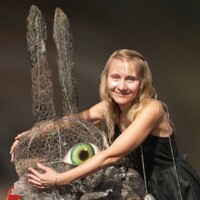Irena Aizen
Little hare in the highest degree
Ilmars Zvirgzds „Little hare in the highest degree: The exhibition of the paintings of Irena Aizen at the Museum of Naive Art"
(Excerpts)
...
As it can be guessed from many known and unknown events, in which the image of a hare is involved, it was not a coincidence, and I went to see the hare.
... Irena Aizen who has received classical art education, has created artworks in the framework of traditional painting for a long time, and has comparatively recently turned to the genre of naive art. This turn was a conscious step that the artist herself has explained in her lectures and interviews, but can be seen the best in her works.
Almost 20 artworks placed in one of the rooms of the Museum of Naive Art, surprise the viewer with the homogeneity of their colour, background and message. The dates of the paintings demonstrate that they have been created in the last three years. It seems unnecessary for me to evaluate the technique of the artworks, especially their material aspects, but they are all impeccable from the viewer’s point of view. In the framework of the naive art, disregarding how disputable this term is, the main thing is the idea and the message of the artist. In the case of the exhibition of Irena Aizen, the main hero is a little hare.
...
Looking for the explanation of the image of hare for a longer time in different mythological traditions, I can claim that the hare of Irena Aizen is close to the concentrate of mythical saturation. The hare who is the symbol of both wisdom and foolishness, the ideal of both fertility and chastity, the bearer of both richness and poverty, most often reveals itself as a dexterous personage who begins processes, unite the split into a whole, gives power and new beginning. Even if nobody is able to confirm or deny the influence of a concrete mythical hare in the works of Irena Aizen, the fact that gods have the ears of a hare from the Far East to the traditions of the North American Indians, is sufficient for the viewer to understand that these traditions have influenced the artist. It is even not so important which traditions these are, because the priority of painting is a visual insight, and careful viewer will notice the independence of the image of hare. The hares in the paintings are similar enough to give the clear signal that in fact, the little hare is one, the only, the universal one. The hare in the highest degree.
In the Jewish tradition and language the concept of hare is connected with cunning. Linguistically, shfanim of Ivrit is clearly related to cunning, therefore, seeing the artworks of Irena Aizen and knowing that she is an Israeli artist, one is surprised because the naive (not in the sense of genre, but in the literal sense) rosy white image of the hare with wide-open eyes contrasts sharply with seemingly well-known linguistic stereotype. This is not a “fake hare” that is on the table and of which everyone is sure that it is not real. This is a little hare, I want to say – hare in the skin of lamb who enslaves the viewers and imposes its thoughts on them.
...
Dominance, friendship, submission, interdependence and the other forms of links and linkages – they are visually shown as different sorts of ties – is only the background of the hare of cosmic scale who fills and maintains everything. Yes, the hare can also be a baby, and in this sense the solution of Irena Aizen has been borrowed from the sacred art – there is no baby hare, because the hare is small only in terms of size, otherwise it is the same adult universal hare.
Another confusing question that perhaps derives from the grammar of the Latvian language, but not from only that, is the gender of hare. Looking at different pictures of hare and reflecting on the mythological functions of hare – for example, a West African myth that the hare had the task to bring people immortality, but it mixed up everything and instead of immortality brought death – the personage of hare associates with a masculine element. The imagination, quick wit, fecundity and agility seem to undoubtedly be masculine symbols. However, the hares of Irena Aizen are all in dresses, if not to count monsters. And even if girls are often called “hares” in the street (why?), it is enough to look into the faces of hares, but moreover into their eyes, to understand that the belonging to a concrete sex or gender is a construction of mind created by laziness. Hare is an androgynous creation who possesses the best and the worst features of both genders. In the painting “Name’s day”, the hare as a white angel flies over a table, here and there, and eternally.
Magazine „Rigas Laiks”, June 2011


